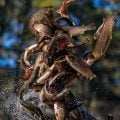How to Tie an Intruder Leech
Producer: Tim Flagler
The inspiration for this fly comes from Landon Mayer’s Mini-Leech. This version, however, is tied intruder-style and is intended to be swung, pulsed or stripped as opposed to dead-drifted. I’ve only been tying and fishing it for a couple of months but so far, I’m happy with its performance.
The foundation of the fly is a 17 mm micro shank. It’s an intruder-style shank with a vertically-oriented rear eye. Begin by getting that rear eye firmly secured in the jaws of your tying vise. A rotary vise works well for this pattern, but isn’t mandatory.
For thread, I’ve loaded a bobbin with a spool of olive UTC 140 Denier. Get the thread started on the shank immediately behind the eye and take a few wraps rearward before snipping off the tag. Continue taking thread wraps to close the front return then wrap rearward and close the return at the back of the shank. End with your tying thread half an eye length behind the eye.
Rotating your vise or flipping the shank over will make it easier to attach bead chain eyes to the fly. For the bead chain eyes, I like medium-sized in black. The idea of these is not really to add weight to the fly, but just to enhance its look and keep it tracking properly. Snip 2 beads free from the chain. Lay the two beads on top of the shank and take cross wraps to secure them. Then take a wrap or two around the shank and do yoke wraps to further secure the eyes. After a couple more turns around the shank, do flat wraps of tying thread to pull everything in and lock it down. End with your tying thread at the rear eye of the shank. You can then return the shank to its original orientation.
For a hook, I’m going to go with a Partridge Z4 intruder in size 8. They’re super sharp and have a slight offset for holding power.
You can use intruder wire if you like, but I prefer 30 pound braided line for securing the hook to the shank. A cauterizing tool makes cutting off a 3” length an absolute breeze. Align both ends of the braid to form a loop then insert those aligned ends, from back to front, through the hook eye. This will allow you to pull the hook up through the loop and secure it to the braid in handshake fashion. Flip the assembly around and place it over top of the shank with a leg of braid on either side. Take a few wraps of tying thread to lightly secure the slippery braid. You want the length of the braid, aft of the shank, to be about as long or maybe slightly longer than the entire length of the hook. This will allow you to replace the hook if necessary.
Begin by taking thread wraps to bind the braid to either side of the shank. Pull the braid up on top of the shank and continue taking thread wraps all the way up to the back of the eyes. Insert the ends of the braid down through the shank eye and carry them along the underside of the shank. Going through the eye like this ensures the slippery braid can’t pull out from underneath the thread wraps. Here again I’m going to use the cauterizing tool to trim the excess braid off close, doing my best not to melt everything down in the process. Then take wraps rearward to the shank’s back eye.
Fluorescent green Angora goat is used to create a hot spot butt on the fly, a small clump is all you need. Set the clump aside and pull down on your bobbin to expose about 6” of tying thread. Create a dubbing loop by first taking a wrap or two around the shank and then a wrap or two around both legs of the loop. You want the legs to come to a point on the shank. Insert the very tip of the middle finger of your left hand into the bottom of the loop and practice opening and closing the loop with your thumb and index finger. Insert the clump of dubbing between the thread strands then squeeze them together to hold the dubbing. Place a dubbing whirl into the bottom of the loop and give it a real good clockwise spin to cord up the dubbing into a fuzzy rope. Rather than wrapping with the whirl, I like plunger-style hackle pliers instead. Take a couple of thread wraps around the tool’s hook hackle before closing them down to avoid slippage. This allows me to snip the excess dubbing loop off close and makes for easier wrapping of the noodle.
Take touching or overlapping wraps with the noodle to build up an ample hot spot at the rear of the fly. This bump will also help to support the pine squirrel tail which will be tied in next. With the dubbing loop secured, snip the excess off close. Preen any forward-pointing material rearward and take thread wraps to hold it back. Loose and scraggly is ok for the hot spot.
Sculpin olive zonked pine squirrel is the only other material needed for this fly. Snip a 4” length free from one of the zonker strips. The thin leather and beautiful dark markings of pine squirrel are hard to beat. With the fur canted rearward, align the back end of the leather with the back edge of the hook. Wet your fingers to separate the fur right in front of the hot spot and take a couple wraps of tying thread to anchor the strip to the shank. Pull the remainder of the pine squirrel back and take two wraps around just the shank, followed by two more over top of the strip. This will help stop it from wanting to rotate around the shank. You can then snip the excess off close, but save the segment for the next step in the tying process. Take thread wraps to cover the butt end of the leather and generally neaten up the area. End with your thread halfway between the eyes and the base of the tail.
Although not absolutely necessary, I like to use 2 chip clips for the next step. These are the good ones. You can tell because they have serial numbers on them. The numbers are written in black Sharpie so you know they’re legit. Get hold of that inch-long remainder of pine squirrel and place the leather edge behind the jaws of one of the chip clips. Pull on the fur side to make sure you have as much as possible sticking out. The leather will keep it from pulling free. Take a second clip and get hold of the hair, like so. Pull the two clips apart ever so slightly and release the clip that holds the leather edge. This will allow you to snip the leather off leaving about 1/16” of pine squirrel fur protruding from the clip. Set this clip aside in a handy place in preparation for the next step.
Once again pull down on your bobbin and form a dubbing loop with the tip of your middle finger at the bottom. Secure your tying thread to the shank in the same manner as before and end with your tying thread at the rear edge of the shank eye. Repeat the same finger calisthenics as before to practice opening and closing the loop. With the workout complete, apply a light skim of dubbing wax to both strands of the loop. Carefully insert the butt ends of the pine squirrel between the two thread strands, then pinch the strands together with the thumb and index finger of your left hand. This will allow you to remove the clip without disturbing the hair. Hook a dubbing whirl into the bottom of the loop and give it a real good clockwise spin cording the pine squirrel into a fuzzy dubbing rope. Use the same technique as before to secure the bottom end of the loop in plunger-style hackle pliers, thus allowing you to snip the bottom end of the loop and the dubbing whirl free. Wet your fingertips and preen the pine squirrel back. Then start taking touching wraps with it up the shank, preening as you go. When you reach the back edge of the dumbbell eyes, go under the shank and pull the bare thread up behind the eye and take several nice tight wraps of tying thread to secure it. Once secured, you can snip the excess off close. Continue to take thread wraps to build up an ample head on the fly, trying not to trap fur in the process. Pick up your whip finish tool and use it to complete a 5 or 6 turn whip finish then seat the knot well and snip or cut your tying thread free.
It’s a real good idea to apply a drop or two of head cement, here Sally Hansen Hard as Nails, to the thread wraps to ensure they don’t come unraveled. Once the cement sinks in and dries, your Intruder Leech is ready to fish. Simply swung down and across or pulsed through the swing, this is a pattern that really produces.
How to Tie an Idaho Killer Kebari
How to Tie an Isonychia Emerger











